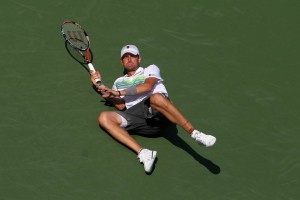They don’t keep records on “most five-setters played in a Grand Slam,” and I’m not planning to pour through decades of drawsheets to research it, but there were 13 matches in the first round alone that went the distance, and we can all be thankful with the 90-degree heat that is frying New York that the U.S. Open plays fifth-set tiebreaks.
Otherwise, Victoria Azarenka might not have been the only player out there collapsing Wednesday. And John Isner vs. Nicolas Mahut? Don’t even think it.
Some of the most unlikely players have had to go five sets at this Open, and some of them won’t be coming back for the second round.
* Lleyton Hewitt, beaten 6-1 in the fifth by Paul-Henri Mathieu.
* Gael Monfils has more than he expected from qualifier Robert Kendrick, winning 6-4 in the fifth.

* Arnaud Clement upsets Marcos Baghdatis 7-5 in the fifth.
* Mardy Fish, in one of his wierdest matches, beats Jan Hajek 6-1 in the fifth after several one-sided sets.
* Jurgen Melzer, another top 20 player, needs five to beat back-from-injury Dmitry Tursunov 6-2 in the fifth.
* Fernando Verdasco needs five to whip little Fabio Fognini 6-3 in the fifth.
* David Nalbandian, whom we all thought was a tournament darkhorse, needs five to beat Rik De Voest — 6-4 in the fifth.
* Robin Soderling looks anything but a second-tier favorite, winning 6-4 in the fifth over big-serving Andrea Haider-Maurer.
***
After three days and two nights (not counting Wednesday evening), the men have left the women in the challenge dust.
The men are averaging 35.1 percent accuracy on their challenges, while the women are at 21.1 percent. Young Brad Klahn of the U.S. was 5-for-5 in his first-round loss. Marcos Baghdatis, who lost in five to Arnaud Clement, was 1-for-6.
Mathieu had 12 challenges in his five-set win over Hewitt and was right five times. But Ana Ivanovic was 0-for-5 and Nadia Petrova 0-for-6. In fact — and I’m not drawing any conclusions here — the Russian women so far are 1-for-14 on challenges.
***
Someone identifying himself as AL2000 wrote a passionate letter to us, very unhappy with the piece I wrote a couple days ago about how the USTA is spending millions on player development and not producing anything close to a top player.
Let me begin by thanking Mr. AL2000. We want to hear from readers and we want a dialogue about tennis. But I’m going to have to refute a couple points the reader produced in defense of the USTA.
He wanted to point out that Christina McHale and Coco Vandeweghe, both of whom have received USTA coaching, are in the U.S. Open main draw this year and that, in fact, this is the second year in a row McHale has been in the main draw.
What the reader didn’t reveal, however, is that both received wild cards into the main draw from the USTA. They didn’t have to qualify and their rankings weren’t high enough to get straight in. They simply had to show the USTA, which runs the Open, that they have “promise.” And they do. But there’s a Grand Canyon of difference between “promise” and “production.”
I’ve had the pleasure of meeting Ms. McHale at a Challenger in Florida. She seems like a very humble, committed player, and she’s gotten her ranking up to No. 112, which, if she can elevate just a little farther, should get her straight into the Aussie Open in January. I hope she makes it.
She won a round at the Open a year ago and that’s a good first step. But she went down in the first round this year 6-3, 0-6, 6-1 to No. 85 Sybille Bammer. Meanwhile, Coco, No. 166, lost 6-1, 6-2 to No. 94 Sabine Lisicki.
You could find some vague golden lining in there if you wanted to. For example, you might point out that McHale won a set and you might consider that a half-step forward.
And if the USTA were spending a lot less money and had just a handful of coaches at one place, maybe this wouldn’t be so much of an issue. You get, as they say, what you pay for. But the USTA is throwing millions at this project and winning a set in the first round of the U.S. Open doesn’t cut it as progress. When you’re shooting this kind of money at a problem, you expect more definitive results.
This isn’t a wholesale critique of American tennis. What we’re doing here is asking a very economic question — the same kind we all ask in our everyday lives. Is the kind of money the USTA investing in player development largely being wasted, when we might get even better results for far less money by simply paying our best prospects to be trained at private academies around the country.
The same academies that have produced Jim Courier, Andre Agassi, Michael Chang and so forth and so on.

